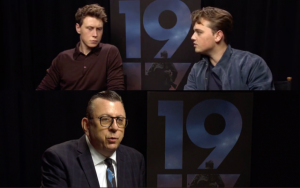PLAYBILL: Critics Sound Off on The Critic, Starring Ian McKellen
 The legendary “Playbill” chose my review of “The Critic” among their top picks for the week.
The legendary “Playbill” chose my review of “The Critic” among their top picks for the week.
Have a look HERE!
 The legendary “Playbill” chose my review of “The Critic” among their top picks for the week.
The legendary “Playbill” chose my review of “The Critic” among their top picks for the week.
Have a look HERE!
 SYNOPSIS: “The Critic,” a new, melodramatic thriller starring Sir Ian McKellen, Gemma Arterton and Mark Strong, and now playing in theatres, sees a powerful London theater critic lure a struggling actress into a blackmail scheme.
SYNOPSIS: “The Critic,” a new, melodramatic thriller starring Sir Ian McKellen, Gemma Arterton and Mark Strong, and now playing in theatres, sees a powerful London theater critic lure a struggling actress into a blackmail scheme.
CAST: Ian McKellen, Gemma Arterton, Mark Strong, Lesley Manville, Romola Garai, Ben Barnes, Alfred Enoch. Directed by Anand Tucker.
REVIEW: A tale of blackmail and revenge, set against the (somewhat) polite society of England, circa 1934, “The Critic” is a deceptively dark and grimy drama.
Handsomely mounted, with sumptuous period details, “The Critic” details mostly despicable people who hide their nefarious motivations behind an upper-class veneer.
Topflight performances from McKellen as a powerful theatre critic who’ll do anything to maintain his status, Arterton as a morally compromised actress and Stone as the nepobaby owner of a large newspaper, smooth over some of the rough patches in the movie’s storytelling.
Early on, actress Nina Land (Arterton) confronts the critic, Jimmy Erskine (McKellen), only to have her worst fears about her talent—or lack thereof—confirmed by the sharp-tongued writer. It’s a masterclass from McKellen in controlled cruelty and tells us most everything that we need to know about the unapologetic character. He’s an extravagant wordsmith, one who uses his words not only to entertain his readers, but to also eviscerate his enemies.
It’s a marvelous scene, sleek and caustic, that sets a tone that is, unfortunately, not continued throughout, despite the good performances. McKellen and Company are let down by a script that, time after time, falls for its basest impulses. Every dark turn, and there are many of them, pushes the story deeper into melodrama at the expense of interesting exchanges like the one detailed above.
“The Critic” slides by on the work of McKellen, Arterton, Strong and Lesley Manville, but doesn’t know how to use their performances to the story’s best advantage.
Cate Blanchett gives a bravura performance in “Tár,” a new 158-minute cancel culture melodrama, disguised as art house fare.
Blanchett is Lydia Tár, the superstar maestro of the Berlin Symphony Orchestra. As she prepares for a landmark recording of Mahler’s Fifth, she is exacting and demanding, on-stage and off. In other words, she is a bully, used to folks kowtowing to her genius.
She quietly belittles her assistant Francesca (Noémie Merlant), and unleashes a withering takedown of a Julliard student (Zethphan D. Smith-Gneist) whose crime was suggesting that Johann Sebastian Bach’s ribald personal life makes the composer unworthy of study.
In Berlin, when she isn’t putting the orchestra through their paces, she lives with partner Sharon (Nina Hoss), who happens to play violin in the orchestra, and stepdaughter Petra (Mila Bogojevic). At work she plays favorites with Olga (Sophie Kauer), a virtuoso cellist who rises through the ranks a little too quickly for the comfort of some of the other musicians.
Just as she is on the verge of major career milestones, a new memoir and the completion of her Mahler cycle of recordings, a crudely edited video of her Julliard lecture surfaces, alongside accusations of professional improprieties with a former colleague.
“Tár” places the emphasis on the wrong end of the story.
We can all imagine the high-flying part of Tár’s life. Images of limousines and private jets, of harried personal assistants and the hushed kind of respect that greeted her in the hallways of power, are all evidence of that.
What is far more compelling, but not as familiar, is the fall from grace. What happens when all you have worked for is taken away, gradually, then suddenly? That’s the real story and it’s the tale “Tár” doesn’t tell. Unfortunately, it spends two-plus hours on the other stuff, and gives a short shrift to the comeuppance in a way that is very unsatisfying.
Despite the imbalance in the story, “Tár” contains some breathtaking scenes, like the aforementioned Julliard sequence. Shot in one take, the scene is a show stopper for both Blanchett and cinematographer Florian Hoffmeister. That the beautiful one-shot take is later snipped into shards and reassembled, like pieces of a video puzzle, is a clever in-joke, and very effective.
The best part of “Tár” is an Oscar-bound Blanchett. In her hands Tár is an intimidator, whether it’s in her job, or at the playground as she browbeats her stepdaughter’s bully. She uses her power like a weapon to get what she wants and in Blanchett’s hands she is a character study of monster, a person cut loose from polite society. She says artists must “sublimate and obliterate” themselves for the art, and yet she is too much of a narcissist to take her own advice.
“Tár” has rewards for viewers patient enough to navigate the film’s poorly paced first hour. The revelation that power can breed monstrous behaviour isn’t new, but it is brilliantly brought to life by Blanchett.
 Richard joins Ryan Doyle and Jay Michaels of the NewsTalk 1010 afternoon show to talk about the history of 007’s other favourite drink, the Vesper, some Oscar news and reviews of “Cruella” and “Moby Doc.”
Richard joins Ryan Doyle and Jay Michaels of the NewsTalk 1010 afternoon show to talk about the history of 007’s other favourite drink, the Vesper, some Oscar news and reviews of “Cruella” and “Moby Doc.”
Listen to the whole thing HERE!
 Richard Crouse makes a Salty Dog, the perfect cocktail to enjoy while paying tribute to animal actor stars of “Cruella,” the latest Disney live-action reboot. Come have a drink and a think about “Cruella” with us!
Richard Crouse makes a Salty Dog, the perfect cocktail to enjoy while paying tribute to animal actor stars of “Cruella,” the latest Disney live-action reboot. Come have a drink and a think about “Cruella” with us!
Watch the whole thing HERE!
“Cruella,” now available in select theatres and on Disney+ with Premier Access, is an origin story that explains the reason why one of Disney’s greatest villains hates Dalmatians.
One eventful day defined Estella’s (Tipper Seifert-Cleveland) life. In less than twenty-four hours, the precious preteen with the distinctive mop of black and white hair, got kicked out of an upscale private school, snuck into a fashion show and thought, “for the first time in my life, I feel like I belong,“ and developed a lifelong hatred of Dalmatians. I won’t say why, but she does have a good reason to harbor animosity toward the spotted dogs. Most tragically, she lost her mother that same day.
Cut loose and alone, she lands in 1964 London. Falling in with petty thieves Jasper (Joel Fry) and Horace (Paul Walter Hauser), Estella (now played by Emma Stone) forms an impromptu family, pulling off scams using disguises designed and made by her own hand.
Still, she’s not satisfied. “I want to be a professional designer,” she says, “not a thief.”
Securing an entry level job at an upscale department store, she gets the attention of The Baroness (Emma Thompson), a cruel, imperious clothing designer who says things like, “Gratitude is for losers.” She is the undisputed matriarch London fashion and will crush anyone who gets in her way.
As Estella rises through the ranks, she becomes aware of a connection between The Baroness and the death of her mother. Until then, she believed she was responsible for her mother’s passing and had gone through the five stages of grief. Denial, anger, bargaining, depression and acceptance. Now she adds a sixth stage, revenge.
“I’m starting to remember that you have an extreme side,” says Estella’s old friend Anita Darling (Kirby Howell-Baptiste).
Determined to ruin The Baroness, break her spirit, her confidence and her business. Estella creates an alter ego, the disruptive Cruella. In a series of staged public stunts Cruella humiliates The Baroness and becomes the darling of the fashion world. “Some call her a designer,” a TV talking head breathlessly reports, “some call her a vandal.”
As the “mad, bad and just a little bit sad” Cruella’s antics escalate, Estella’s personality grows fainter. “I’m not sweet Estella, try as I might. I’m Cruella.”
“Cruella” has lots going for it. Great costume design, a rippin’ soundtrack and arch attitude, but by the time the end credits roll, it is all about the dueling Emmas, Stone and Thompson.
“Wow,” says Cruella. “You really are a psycho. “How nice of you to say,” The Baroness snaps back.
Both hand in flamboyant performances that capture the wickedly humorous tone of the story.
Stone’s performance straddles the line between her two characters as Estella’s attempts to fit into the regular world fade, as bits and pieces of Cruella’s anything goes mentality filter through until she goes full-on baddie. The punk rock-glam inspired clothes help in the transformation, but the heart comes from Stone, who does something difficult, bring a tragic heart to a villain.
As The Baroness, Thompson is the is the Queen of the Side Eye. It’s a wonderfully comedic performance, equal parts disdain, evil and ridiculous, she redefines arrogance. Think “The Devil Wears Prada” with a sharper edge. It’s the kind of work you want to watch at least twice to catch all the small bits of business she weaves into the performance.
Propelled by the performances and a music-heavy soundtrack featuring everything from The Doors and Nina Simone to Iggy & The Stooges (this must be the first Disney film to feature the proto-punk tune “I Wanna Be Your Dog”) and Tina Turner, “Cruella” rocks along at a clip until it loses steam near the end as it prepares itself for the sequel.
Until then, however, “Cruella” is the most audacious of the recent live action reimaginings of a classic Disney character.
 This week on The Richard Crouse Show: Richard chats with “1917” co-writer Krysty Wilson-Cairns about tending bar, working with Sam Mendes and writing a film that is presented in one shot. Then he speaks to the two stars of the Fist World War story to discuss creating the characters and the challenges of shooting the epic film. Then we meet “Rise of the Skywalker” star Joonas Suotamo about playing the iconic Wookie character Chewbacca, and what it is like wearing the fur suit for ten hours a day and Yvette Nicole Brown who plays Aunt Sarah in the Disney+ version of “Lady and the Tramp.” They talk about adopting rescue dogs, wearing corsets and if Brown agrees that her character is the villain of the story.
This week on The Richard Crouse Show: Richard chats with “1917” co-writer Krysty Wilson-Cairns about tending bar, working with Sam Mendes and writing a film that is presented in one shot. Then he speaks to the two stars of the Fist World War story to discuss creating the characters and the challenges of shooting the epic film. Then we meet “Rise of the Skywalker” star Joonas Suotamo about playing the iconic Wookie character Chewbacca, and what it is like wearing the fur suit for ten hours a day and Yvette Nicole Brown who plays Aunt Sarah in the Disney+ version of “Lady and the Tramp.” They talk about adopting rescue dogs, wearing corsets and if Brown agrees that her character is the villain of the story.
Listen to the whole thing HERE!
Here’s some info on The Richard Crouse Show!:
Each week on the nationally syndicated Richard Crouse Show, Canada’s most recognized movie critic brings together some of the most interesting and opinionated people from the movies, television and music to put a fresh spin on news from the world of lifestyle and pop-culture. Tune into this show to hear in-depth interviews with actors and directors, to find out what’s going on behind the scenes of your favourite shows and movies and get a new take on current trends. Recent guests include Ethan Hawke, director Brad Bird, comedian Gilbert Gottfried, Eric Roberts, Brian Henson, Jonathan Goldsmith a.k.a. “The most interesting man in the world,” and best selling author Linwood Barclay.
Click HERE to catch up on shows you might have missed!
 Richard sits down with Dean-Charles Chapman and George MacKay, the two stars of the Fist World War epic “1917” to discuss creating the characters and the challenges of the one-shot technique used to film the movie.
Richard sits down with Dean-Charles Chapman and George MacKay, the two stars of the Fist World War epic “1917” to discuss creating the characters and the challenges of the one-shot technique used to film the movie.
Watch the whole thing HERE!
SYNOPSIS: At the height of the First World War, two young British soldiers, Schofield (Captain Fantastic’s George MacKay) and Blake (Game of Thrones’ Dean-Charles Chapman) are given a seemingly impossible mission. In a race against time, they must cross enemy territory and deliver a message that will stop a deadly attack on hundreds of soldiers—Blake’s own brother among them.
“1917” is a simple story of duty wrapped up in a high gloss technological package that delivers a vividly immersive look at life during wartime.
Designed to look like one continuous shot, the action in “1917” begins in the trenches of Northern France with two men, Lance Corporals Schofield (George MacKay) and Blake (Dean-Charles Chapman), assigned a dangerous mission. With telephone lines down, their general (Colin Firth) dispatches the pair travel through No Man’s Land on foot to the front lines. If they can make it past the barbed wire, booby traps and German snipers, they are to deliver the message that the Germans have set a trap, enticing the unwitting British to attack. “If you fail,” says the general, “it will be a massacre.” If Schofield and Blake are successful they could save 1600 lives, including Blake’s Lieutenant brother (Richard Madden). But first they must travel through eight miles of the most dangerous territory on earth.
It’s easy to feel that “1917” is a gimmick film. In the opening scenes I found the continuous, one shot nature of the filmmaking a distraction. I kept wondering, “How is Sam Mendes doing this?” or looking for clever, surreptitious edits. It took me out of the story but once accustomed to the gliding camerawork by the legendary Roger Deakins I began to focus on the story’s tale of bravery and resilience and less on the trickery that created it.
The horrors of war are duly represented—there’s barbed-wire, dead, rotting bodies litter the landscape and a bombed-out town is nothing more than the skeletons of buildings—but “1917” doesn’t focus on that. This is a contemplative story of a mission and the men who sacrifice their own safety for the greater good. It highlights the ever-present danger of attack but it’s the character’s emotional journey that makes for the compelling story. Blake wants to stop his brother from walking into a trap while Schofield is driven by a sense of duty. Both men are working for the collective, which in our era of the individual, is a potent reminder of the importance of cooperative effort.
“1917” is a beautifully grim movie. Death lurks around every corner and the success of Blake and Schofield’s mission is never assured. Hope is a remote, elusive concept in the theatre of war but Mendes weaves in enough humanity—the relationship between the soldiers, a scene with a French mother and her daughter—to give us a window into the horrors of war.